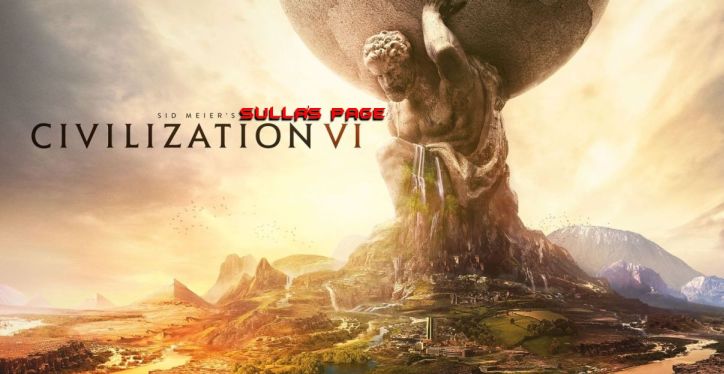

Link to the PBEM17 Forum at Realms Beyond
It's been a while since I featured a Civ6 Multiplayer game on my website. Realms Beyond has continued running Play By Email (PBEM) games for Civ6 even if the community has never quite taken off to the same extent as it did for Civ4. I took part in the giant PBEM7 game in 2018 together with Singaboy as my teammate and that game is more than deserving of a writeup. However, that game was so enormous and had so many events take place that I could never find the time and energy to put a full writeup together. That game was also played on the final patch version of the non-expansion version of Civ6, and it's been hard for me to summon up the desire to write in minute detail about game mechanics that no longer exist thanks to changes added later in the expansions. As a result, I'm not planning on putting a huge report together for the PBEM7 game. I may do something smaller just to capture the endgame naval war between myself and Chevalier but that would be it.
Instead, I thought it would be more useful to look at a more recent PBEM game that took place under the Gathering Storm expansion. There have been a lot of changes to the Civ6 mechanics in the two expansions and I'll try to highlight them in this report as it progresses. I chose to highlight PBEM17 despite not playing in this game because it featured a particularly brilliant pattern of economic development from The Black Sword (TBS). He played what was almost certainly the best game that our community has seen to date in Gathering Storm, and I'm writing this report at least in part to better understand what he did for my own benefit. This is not a report featuring lots of dramatic twists and turns or tons of fighting, instead mostly highlighting a builder's game done exceedingly well. To summarize, this is the story of the perfect economic snowball as demonstrated by TBS and the Cree.
This game ended up with seven total players. Each of them chose their civilization from a list of four choices sent to them by the community; here's what they each picked:
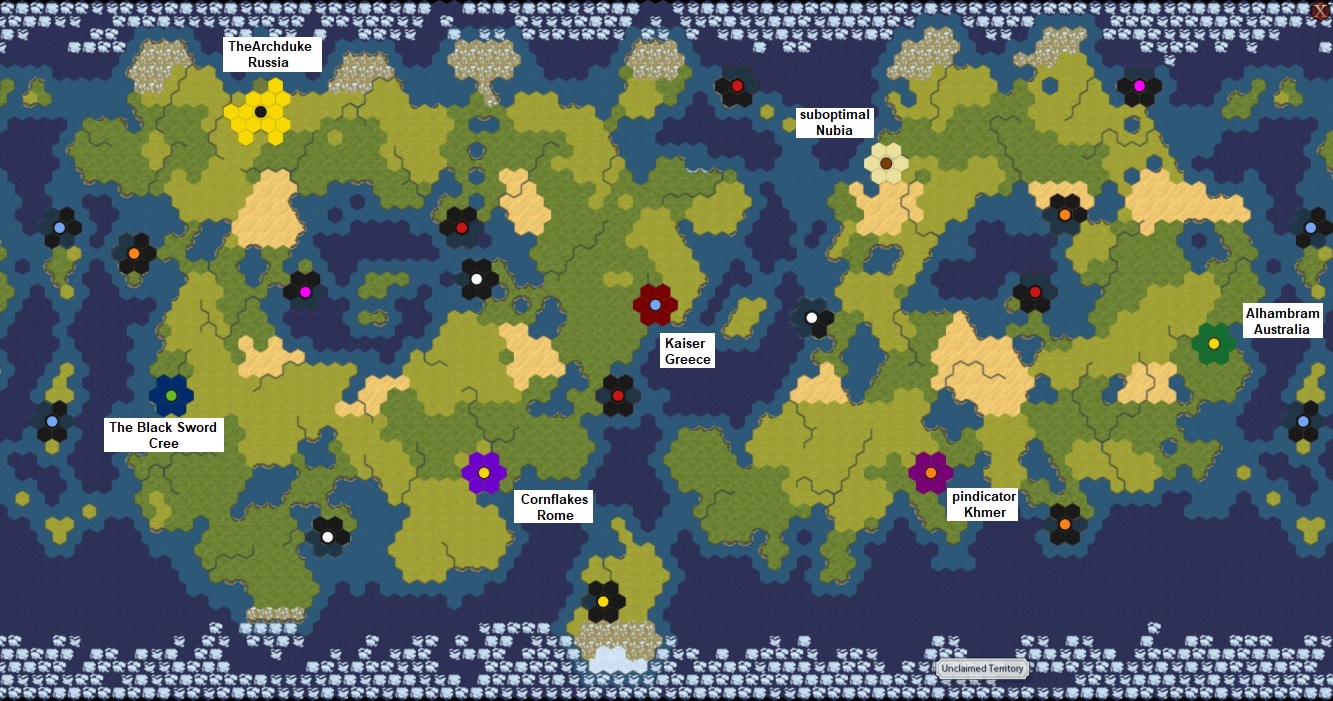
Alhambram: John Curtin of Australia
Cornflakes: Trajan of Rome
Kaiser: Gorgo of Greece
pindicator: Jayavarman of Khmer
suboptimal: Amanitore of Nubia
The Black Sword: Poundmaker of the Cree
TheArchduke: Peter of Russia
Woden put together the map and did a fantastic job, creating two main continents along with several offshore island with city states for the players to fight over. After having to go through herculean efforts to jerry-rig customized maps in earlier versions of Civ6, by the time of the Gathering Storm expansion there was finally an official Worldbuilder to allow for easier game setups. The larger of the two continents would contain TBS, TheArchduke, Kaiser, and Cornflakes while the smaller continent would have a tripartite split between Alhambram, pindicator, and suboptimal. Obviously the players did not know what the map looked like ahead of time and would have to explore it on their own.
TBS picked the Cree over his other potential options of India, the Dutch, and the Ottomans. I'll readily admit that I didn't think too much of the Cree as a civilization and couldn't see what it was that made them a strong pick. TBS explained the reasoning in his spoiler thread as far as why he was choosing them:
|
The Black Sword: |
TBS correctly identified the Cree as being a civ that offered early advantages, taking place at a point in time when they would do the most to speed up the overall growth curve of a civ. I hadn't been terribly enamored with the Cree because their unique unit doesn't provide much of a benefit, a scout with higher strength that also costs more than a normal scout at a time when it's better to have cheaper units. However, the Okihtcitaw is the smallest part of the Cree package, much like how the Quechua unique unit for the Inca in Civ4 isn't the main reason why they get valued so highly. Mekewaps in particular are an incredible tile improvement, adding both production and housing to tiles along with the potential for more food and commerce if they happen to be placed next to enough resources. As TBS said, they solve the problem of "what improvement do you build on your flatland tiles?" which are otherwise pretty useless in Civ6 for anything other than building districts. And the Cree also get a free trade route in the early game along with extra food and gold on every trade route based on the number of camps and pastures in the destination city. This was a much, much better benefit than I had realized and can turn into an explosive start if the Cree end up having camp/pasture resources at their early cities.
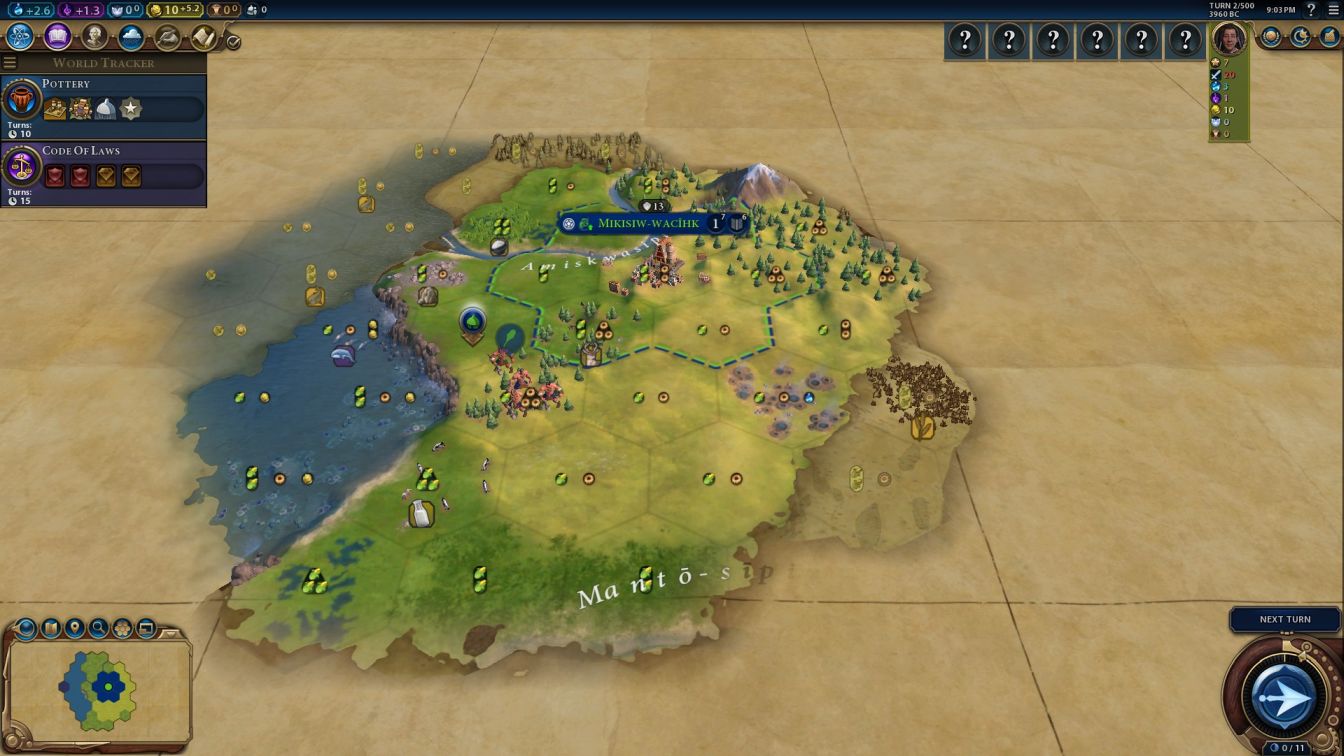
As it turned out, TBS did have both camp and pasture resources at his capital city. He had started on the grassland tile to the west and then moved onto the plains hill tile on the first turn of the game. This picked up 2 production for the center tile of the capital and pulled a whole bunch of forested plains hill tiles into range of the initial city borders, leading to a much stronger overall capital as compared to the original starting tile. TBS started out by working the 2 food / 3 production deer tile while training an Okihtcitaw and growing to size 2. This meant slower growth as compared to staying in place and working the 4 food rice tile but much, much higher production and that almost always tends to come out ahead in Civ6. This is a very different game from Civ4 where emphasizing high food tiles is nearly always the best decision.
After a dozen turns of uneventful exploring, TBS posted an updated picture of his surrounding neighborhood:

Compare to the world map above to get a sense of where TBS was situated in the southwestern corner of the larger continent. His capital city had started out with the initial training of the unique unit Okihtcitaw, a no-brainer decision to make use of the early game strengths of this Cree unit. I generally don't like opening with a scout because they're too weak to fight off barbarians but the Okihtcitaw is a special case given how they have +10 strength over a normal scout and start with a free promotion. Then note what TBS chose to do next: he started building a settler at size 2 while working heavy production tiles. Between the city center tile (2 production), the capital's palace (2 production), the deer tile (3 production), and one of those forested plains hill tiles (3 production), his capital city was knocking out an impressive 10 production/turn here in the very early game. This translated into an 8 turn settler since they start at 80 production cost and increase by 30 production for each settler completed. Finishing the settler would knock the Cree capital back down to size 1, but the food costs to grow scale up quickly in Civ6 and it's cheaper to regrow population at smaller sizes. Better to lose a population point that costs 15 food to regrow as opposed to a pop point that takes 55 food to regrow.
There's a long-running question in Civ6 as far as whether it's better to train a builder first or a settler first. The general rule is that it's better to start with a builder if the local terrain around the capital is weak, or if the capital is pumping out lots of early culture and needs a fast builder to avoid wasting your advantage by skipping the Craftsmanship boost. Only if the capital has very strong terrain should a player start on a settler immediately. Fortunately for TBS that was exactly the case here: PBEM17 took place on an extremely fertile map where all seven players had powerful starting locations. The Cree had a 5 yield tile (the deer with 2 food / 3 production) and a whole bunch of 4 yield tiles without needing builder improvements. This was exactly the situation where settler before builder was the correct decision - the starting tiles were already awesome and didn't need more help.

Here's a picture of the inside of the Cree capital at this early date showcasing how TBS was working the deer tile and one of the forested plains hills. TBS spent 50 gold to purchase the rice tile so that he would be able to farm it for the Irrigation boost with his first builder, and this had the fortunate side effect of causing the tile picker to grab a horses resource that popped up west of the deer tile on the next cultural expansion. The settler also lined up almost perfectly with the food box in the capital city: this picture shows the city at 11/24 food growing towards size 3. However, when the settler finished on the next interturn, the city instantly dropped to size 1 and then gained 2 food from no longer needing to feed the second population point, ending up at 13/15 food in the box. This allowed TBS to work the deer tile and then regrow back to size 2 again after only a single turn at size 1. This may be getting a bit too far into the technical details of Civ6 production mechanics for most readers so here's the takeaway: TBS was able to get out his settler incredibly fast while paying the minimum cost possible in lost food.
That settler was headed for the tile southwest of the silks, down by a pair of mountains in the south. This spot had three pasture/camp tiles to benefit from the Cree bonus on trade routes, and when TBS finished his research into Animal Husbandry, it turned out that there were horses there as well:
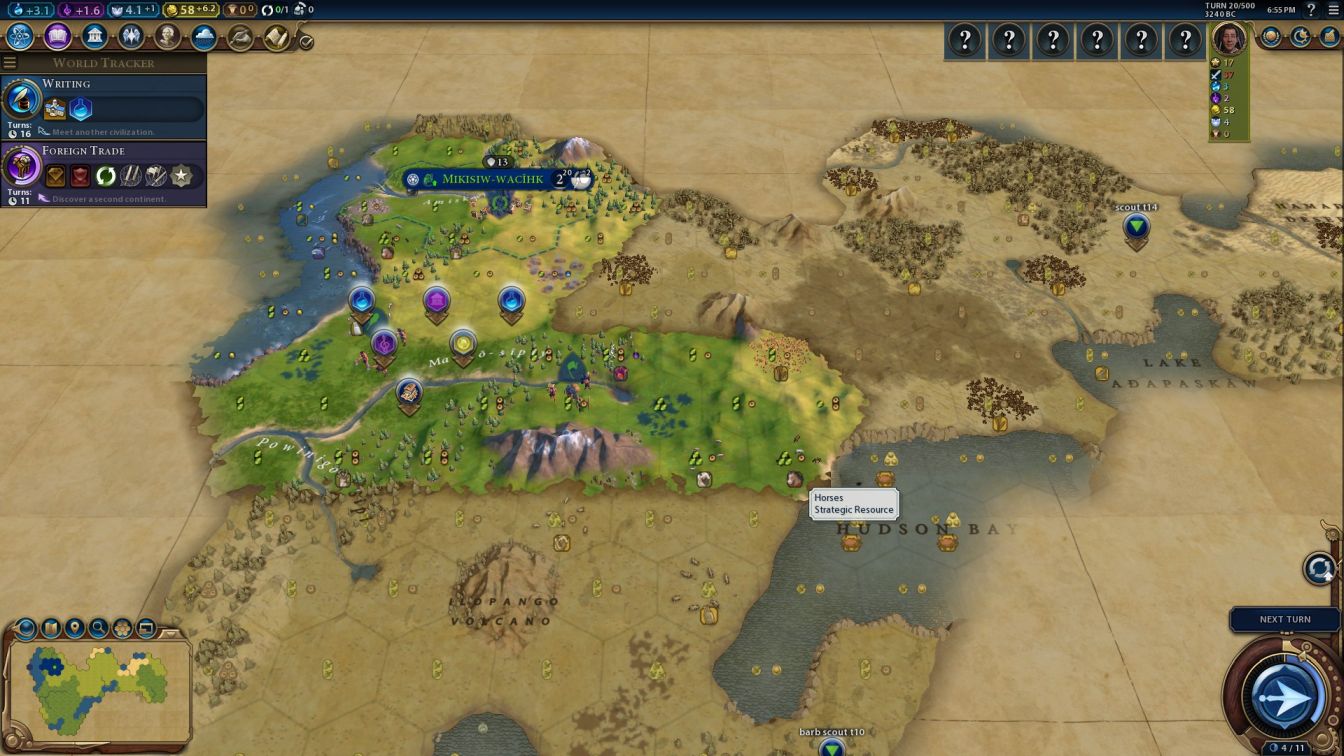
This might have initially seemed like a somewhat strange location for the second city given that there were two useless peak tiles in the first ring. However, TBS chose an excellent location because it would be able to get off to a fast start with a powerful starting tile (the forested hill silks with 2 food / 2 production / 1 culture yield) and then grow onto those horse and sheep and cow and deer tiles out in the second and third rings. The two sheep tiles would be guaranteed to be picked up quickly by the tile picker as the only resource tiles in the second ring and then TBS would have the option of spending more gold to purchase other resource tiles further out in the third ring. Remember that the Cree trade route bonus provides extra food based on the number of camp and pasture tiles at the destination city. In order for TBS to get the maximum benefit out of his civ, he needed his capital and his second city to have a bunch of these resource tiles. That's not guaranteed and the Cree are much weaker if they don't have the good luck to roll those particular resource clusters. (The Cree are also weaker on maps which aren't as turbocharged with abundant resources as this one happened to be.) But TBS had deer + horses at the capital and picked out a second city with double sheep + horses + cows + deer. This was going to create some fantastic trade routes at a very early date.
At the same time that the second city was being settled, TBS was finishing up with a builder in his capital city, running the same high production tile configuration to train it in just five turns. It wasn't enough just to have deer and horses at the capital for his trade route benefit to kick in, those resources also had to be improved with camps and pastures, and that required having a builder on hand. This initial builder would improve those two tiles along with farming the rice for the previously mentioned Irrigation boost. Sharp eyes may have noticed the trader unit in the above picture; that was another part of the Cree unique benefit showing up at the discovery of Pottery tech. They are the only civ who gets this free trade route just for discovering a tier 1 technology. TBS moved the trader to his second city and took advantage of the camp/pasture combo finishing at the capital:
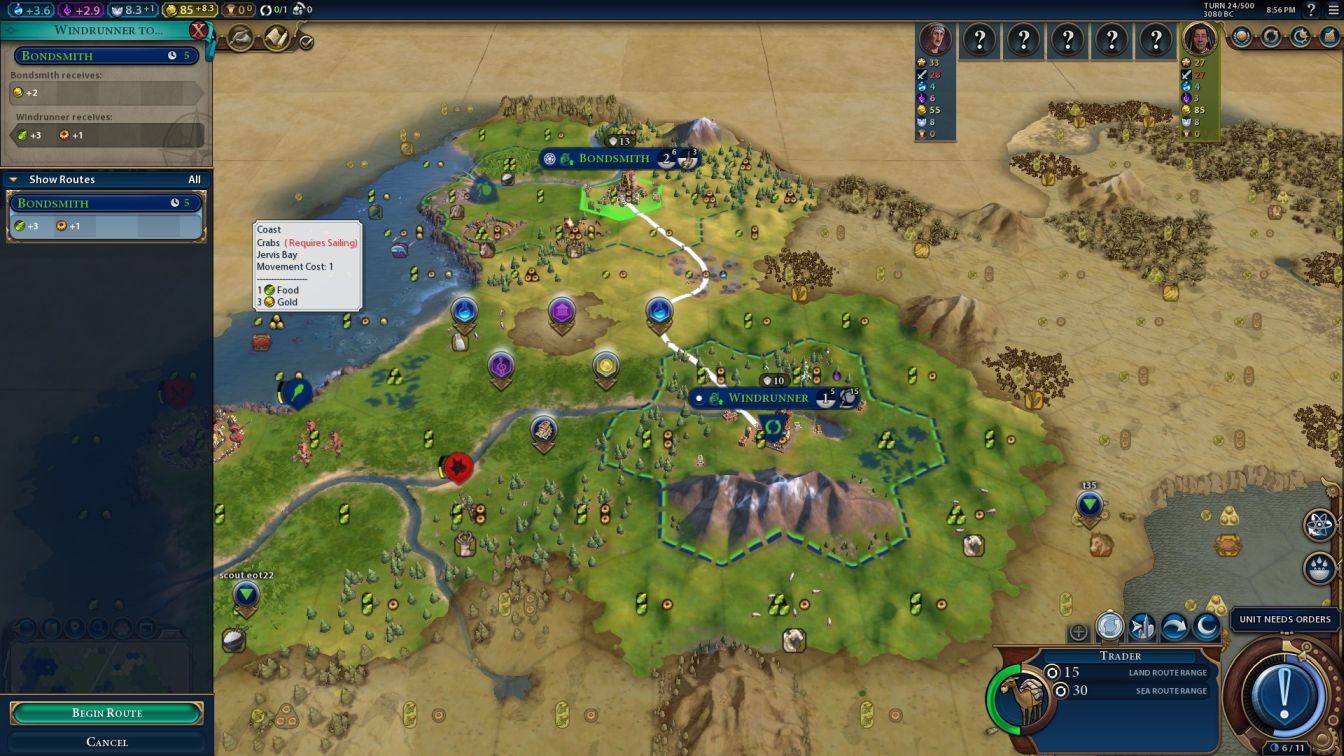
The base yield for a trade route in Civ6 is 1 food and 1 production per turn, and that would have been the result of this trade route under normal circumstances. However, the unique Cree bonus kicked in 2 additional food from the camp + pasture combination back at the capital to increase this up to 3/1 yield, and that was a very big deal indeed. The one weakness of the second city spot that TBS had chosen was somewhat weak food output, no tiles with more than 2 food yield in the initial ring. The trade route solved that problem instantly by adding 3 food each turn and fueling rapid city growth. (This was even better than it might sound since it was 3 food divorced from needing to feed a population point, effectively the equivalent of working a 5/1 tile.) Furthermore the trade route would also kick in 2 gold/turn back in the capital as a side bonus, plus culturally acquire two tiles along the trader's path for free. This would save TBS from having to purchase the tile where the Campus district of his second city would be placed. Every little bit helps in Civilization.
This was also the point in time where TBS renamed his cities over to a Stormlight Archives naming theme, making the names a lot easier to type than the default Cree options. The capital of Bondsmith followed up the initial builder with an unusual choice: a monument. We typically don't see players opting into an early monument in Civ6 but it was a good choice from TBS here. He wasn't in Agoge policy to get a production bonus on melee units and he wasn't being harassed very much by barbarians. His Okihtcitaw was out doing some deep exploring and had picked up the Foreign Trade boost by discovering a second continent while the starting warrior was clearing the one barbarian camp that had popped up nearby. The biggest weakness for TBS at the moment was culture since he had no civ abilities that provided culture and he hadn't found any cultural city states. Building an early monument and working the silks tile at the second city of Windrunner allowed him to work around this weakness, keeping his culture at a healthy pace during these early turns.
The deep exploring Okihtcitaw eventually stumbled across TBS' neighbor to the east:
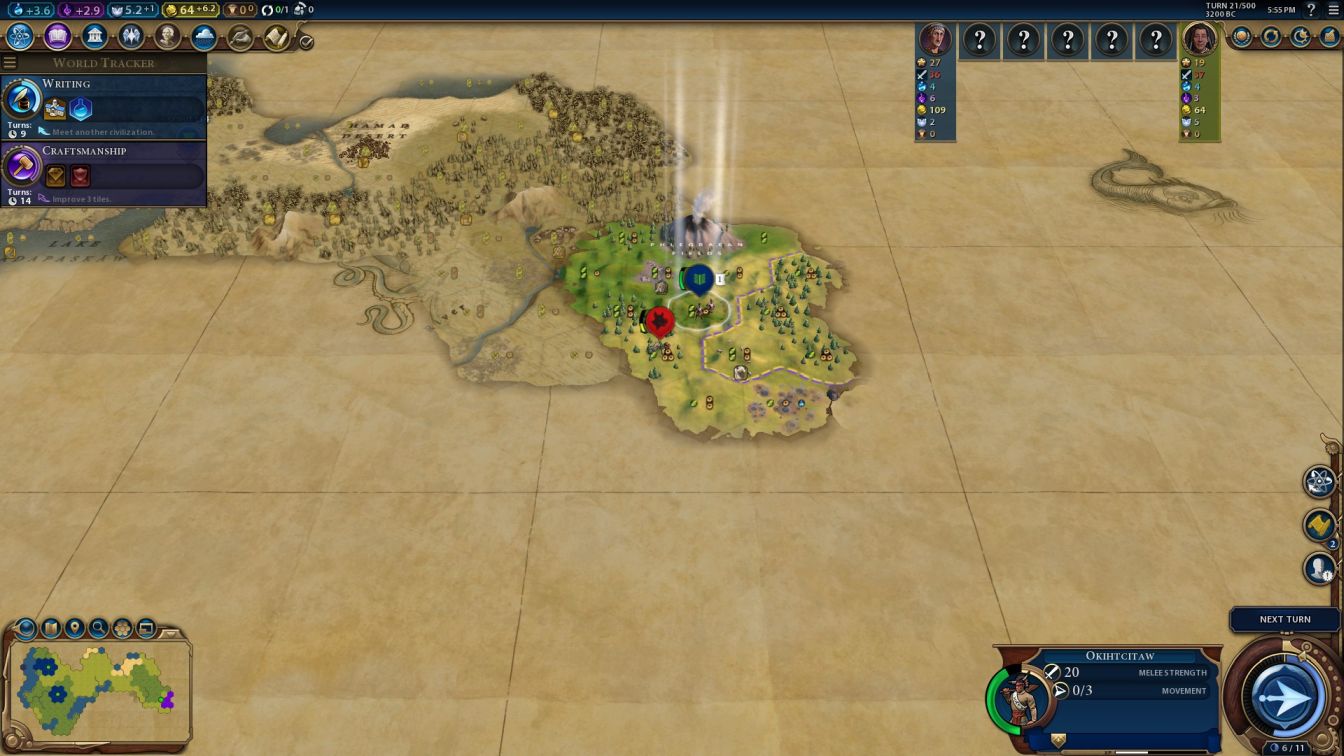
This was Cornflakes of Rome and that wasn't the neighbor that TBS would have preferred. Rome is an early game snowball civ that zooms through the culture tree faster than anyone else with free monuments and then can either hit someone with their powerful legions or look to build upwards with their unique Bath districts. (If you're reading this report, you're probably at least somewhat familiar with Rome since I played them in both the PBEM1 and PBEM7 games; there might be a few words written about them on this website.  ) TBS hoped to set up a defensive border city somewhere in between their starting locations and crossed his fingers that the legions would march off towards a different neighbor.
) TBS hoped to set up a defensive border city somewhere in between their starting locations and crossed his fingers that the legions would march off towards a different neighbor.
I'll add two additional observations on this point. The first is the single best feature in the Gathering Storm expansion: the comparison bar at the top-right corner of the screen. From top to bottom, this shows the empire score, military strength, beaker rate, culture rate, current gold, current faith, and diplomatic favor of all other civilizations met to date. All of this information was present in the release version of Civ6 but required tedious digging into the score panel to view. This new feature in the expansion makes it much easier to see what's going on at a glance and it gets a huge thumbs up from me. (For some bizarre reason it is *NOT* the default option and must be turned on in the options menu - what the heck, Firaxis?!) The other observation is something that TBS hadn't been finding: city states. His scouting Okihtcitaw had gone to the east and missed out on the two city states to the north, then barely missed seeing the religious city state of Jerusalem located halfway between Cree and Rome. TBS therefore had no early freebies from city states at all to accelerate his start. Everything that he pulled off in these opening turns took place without scoring any free envoys for additional culture or science or faith or production.
TBS produced some strong reporting for this game but it tended to be high quality, not high quantity. There were many turns that went by with no posting and no images. For example, there was a gap of eight turns between Turn 24 and Turn 32 when the next post appeared:
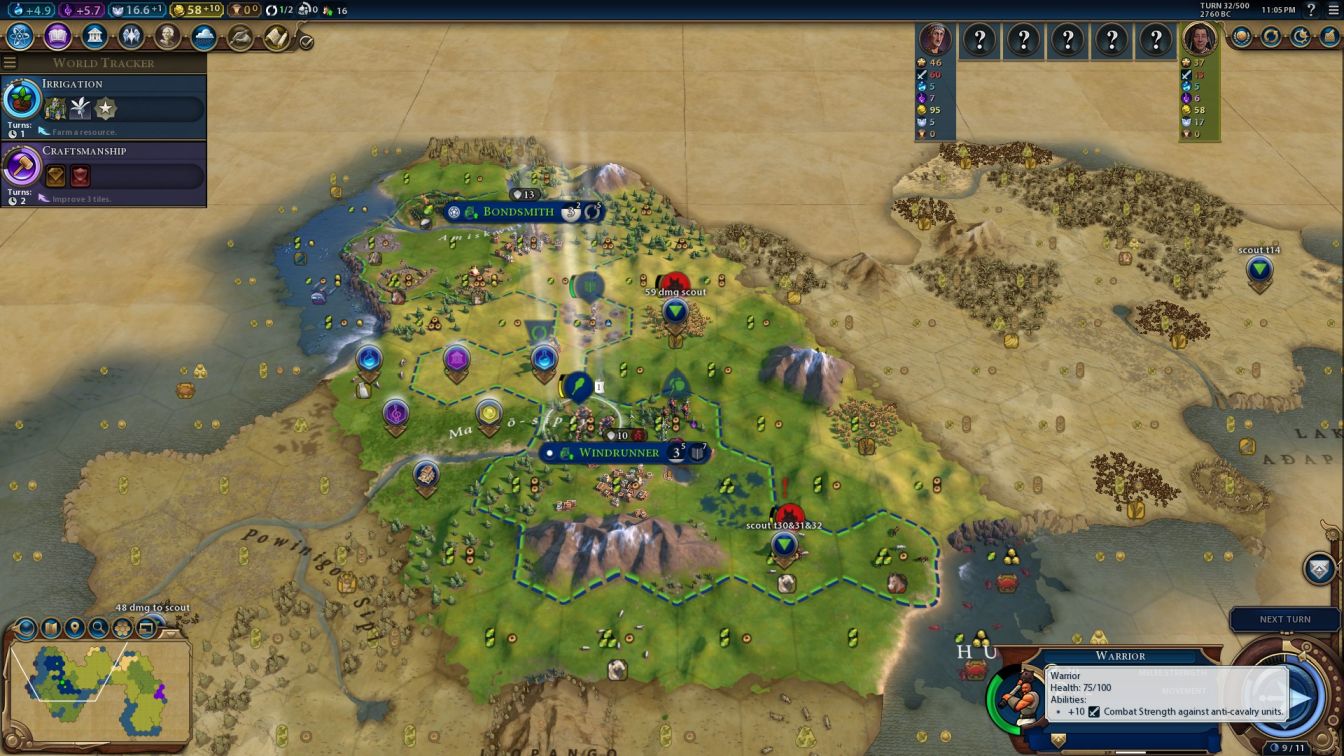
During the intervening turns, TBS trained another Okihtcitaw in the capital of Bondsmith and finished a builder in Windrunner. This builder was now about to add a plantation on the silks to solve the happiness crunch and then improve the sheep and horses with its remaining two charges. TBS had purchased the horses out in the third ring at Windrunner, a good use of gold since it provided another strong tile for the city to work and also boosted trade route yield thanks to the Cree unique ability. Note that a second trader had just been started in the capital, the trade route that unlocks naturally in every game from discovering Foreign Trade civic, and it would be sent from the capital over to Windrunner to create a pair of 3 food / 1 production / 2 gold trade routes. All of this extra food was causing the Cree cities to grow at lightning-fast rates while still working heavy production tiles at all times. Other civs simply cannot do this: it's only possible with the Cree trade route benefits with the proper pasture/camp tiles in place.
TBS had been carefully managing his civics research to ensure that he was running the policies that he wanted at all times. For example, he was only running the weak God King policy long enough to generate 25 faith for a pantheon, planning to discover Early Empire civic and swap into Colonization policy on the very turn that he hit 25 faith. This meant that he didn't need to train settlers until Colonization was in place and that gave the capital time to construct a district for the State Workforce boost. The district in question would be a Campus district located on the cows tile next to the ocean out in the third ring of Bondsmith. This Campus spot would have +4 beakers from being located next to two reef tiles (in the water) and then another +1 beaker from the future Government Plaza. For that matter, Windrunner's first district was also slotted to be a Campus where it would pick up +3 beakers from adjacency bonuses from being next to the same Government Plaza and a geothermal vent. Campus districts with good adjacency bonuses are even more important in Gathering Storm since the beakers from Scientific city states and population points have been nerfed since the release version of the game. TBS was setting himself up for some beautifully placed districts down the road.
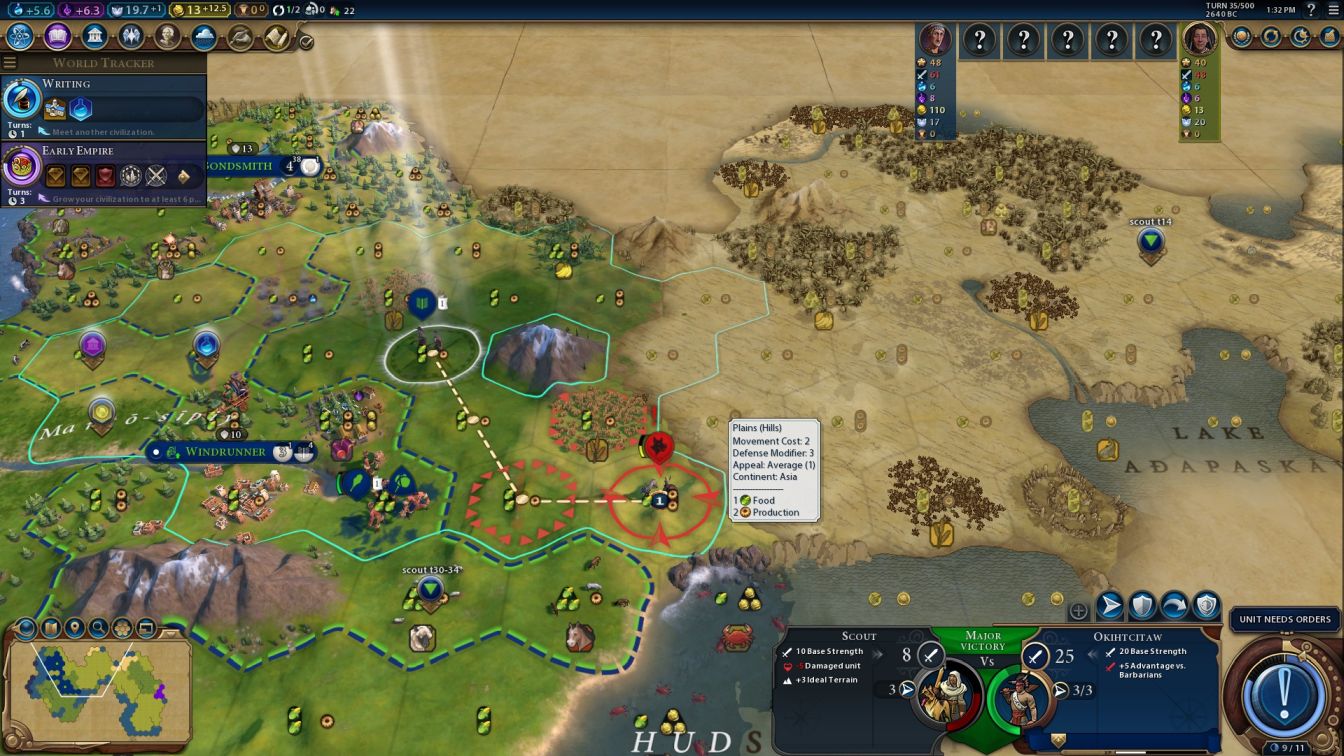
Even the Okihtcitaws were getting in on the action. This isn't an especially good unique unit but it does have its uses at times; this was a case of taking the "move over hills" promotion and using it to smack this barbarian scout. TBS ended up training the right amount of military for his opening, exactly enough units to explore the map and pick up the key boosts (Writing, Foreign Trade, etc.) and keep the barbarians down without training more units than necessary. He defogged plenty of the map and simply had bad luck in not running into any of the city states.
At the end of 35 turns, TBS was out to a roaringly fast start. He had an extremely powerful capital pulling in 15 base production/turn (!) at size 4 along with a strong second city pushing 10 production/turn. He was successfully using the Cree's trade routes to push food while also working high production tiles in both cities. Science and culture were keeping pace with Rome despite not finding any city state envoys and not getting the free culture from Roman monuments. (Cornflakes even took the Fertility Rites pantheon that awarded a free builder and yet he wasn't decisively ahead in the rankings.) This was a near-perfect opening sequence that set the scene for the Cree to stage future dramatic performances.



